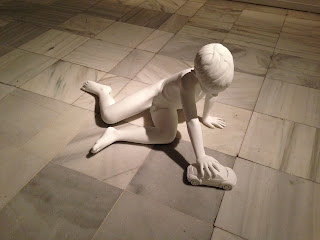 |
| Martin Kippenberger.1985. Photo: Alejandra de Argos |
I went into the exhibition expecting to see the major works of the most important artists from the 18th century to the present day - the exhibition, however, is less interested in the works themselves and instead focuses on taking visitors on a journey through life, identity, drama, memory and obscurity. Key moments in the artists’ lives are recreated for us through their artwork.
 |
| Étienne- Martin. Photo: Alejandra de Argos. |
The common thread running through the works on display is that the artists themselves, not biographers, are responsible for the personal stories they create for themselves with their art. Literary examples of this process can be found in Franz Kafka and Gérard de Nerval: Kafka’s childhood was strongly shaped by his authoritative father, and in Nerval’s case by the death of his mother.
As I continued through the exhibition, it became clear that all the artists had suffered a tragic or difficult childhood which led them to lead a continuous search for meaning in adult life. For these artists, art is a channel for their anxieties, a source of self-knowledge. The process of creation serves as a means to reach our innermost being, our desires and impulses, or to exorcize our personal demons.
Childhood spaces are a common motif in the works on display: the artists’ first bedrooms, the houses they lived in, even their own bodies. Spaces that are both intimately tied to one’s early years, and that help form the identities we will later inhabit as adults.
 |
| Michelangelo Pistoletto. Photo: Alejandra de Argos |
The first item we see as we enter is Michelangelo Pistoletto’s highly-polished stainless-steel plate with standing figures painted on it, the steel plate acting as a mirror announcing our arrival and making it come to life. The ideas of reflection, identity and identification are present from the very start of the exhibition with this piece, and its mirror effect, and have long been present in all of Pistoletto’s work. The artist does not personally interpret reality - he reflects it back at us. Even Freud reminds us of the importance of one’s body image in creating our self identity.
"The artist is not separate from his work. I am the artist and the artwork at the same time, the creator and the Universe. The subject and its reflection. The artist and society". Pistoletto.


In this painting by Martin Kippenberger, an artist profoundly inspired by Picasso, he depicts himself floating in thin air dressed like the Picasso in the photo, thereby reproducing the great Andalusian painter’s identity. Kippenberger believed that self-portraits are a tragic representation of one’s own existence.
 |
| Paul Klee. Photo: Alejandra de Argos |
Here we have a drawing by Paul Klee of his own bedroom. The bedroom is seen as the origin of our identity - it is where we spend most of our time as children - and as representing our first childhood memories. According to Nerval, identity is primarily formed by one’s family name and one’s first bedroom.
 |
| Paul Klee. Photo: Alejandra de Argos |
 |
| Mark Rothko. Photo: Alejandra de Argos |
Philip Guston, a painter and printmaker whose work resembles cartoon strips, was interested in identifiable elements or signs of a bodily nature: toes, fingerprints and eyes.
 |
| Philip Guston. Midnight Pass Road.1975. Photo:Alejandra de Argos |
 |
Philip Guston. Photo: Alejandra de Argos
Edvard Munch is also present in this exhibition, a fascinating painter whose life and work were clearly and deeply affected by a tragic childhood which saw the death of his mother and the influence of an obsessively religious father. Drama and anxiety, ever-present in Munch’s life, are staples of his artwork, as we can see in this painting, The Dead Mother and Child.
Another great example of an artist’s childhood being reflected in his identity and work is Louise Bourgeois: memory, and space as creator of identity, are the major themes throughout his art. We witness the artist’s traumas, fears, obsessions through his work. We can thus glean a clear picture of his personality from his paintings; similarly, his work cannot be fully understood if separated from his biography. This sculpture is about whispers, created at a time when the artist was feeling the absence of his mother after she had moved to the US.
This work by Alina Szapocznikow, made out of polyester resin, looks like it’s been taken from a Pietà sculpture. The hollow figure, almost suspended in thin air, with the resin giving it an organic feel, clearly symbolizes the instability of the artist’s own life, whose mother died in a concentration camp.
 |
| Alina Szapocznikow. Piotr.1972. Photo: Alejandra de Argos |
 |
| Ray Charles. The new beetle. 2006 Photo: Alejandra de Argos. |
I’d like to end with a quote...
"He who has a why to live for, can bear almost any how."
Friedrich Nietzsche.
 |
| Dorothea Tanning. Chambre 202, Hôtel du Pavot. 1970. Photo: Alejandra de Argos |

 Cambiar a versión en Español
Cambiar a versión en Español

No comments:
Post a Comment
Muchas gracias por compartir tus comentarios